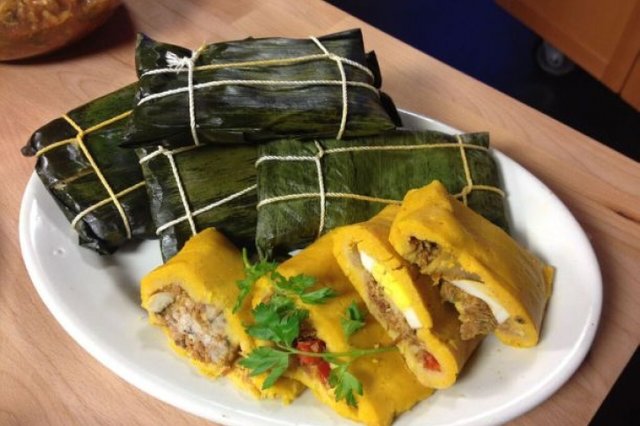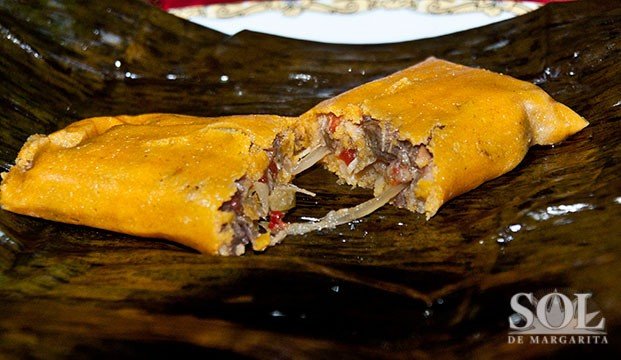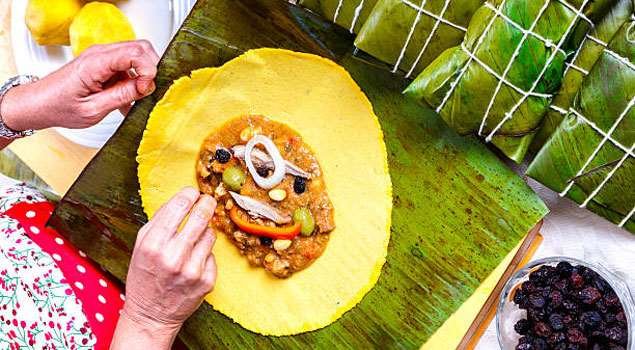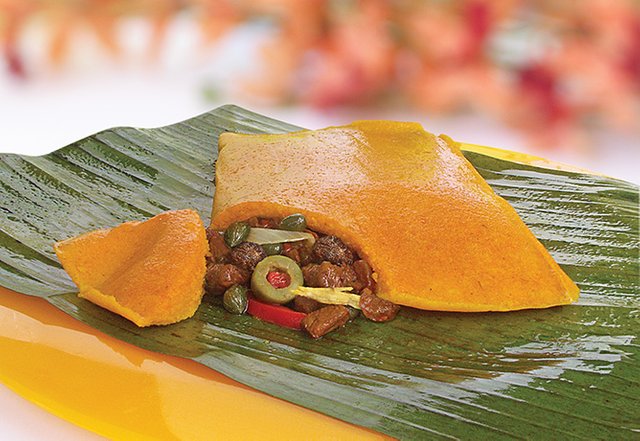The hallaca
The hallaca is traditional in Venezuela and also popular in Colombian cities near Venezuela, such as Cúcuta and Barranquilla (where it can be found all year round), on the island of Curaçao and its neighbors Aruba and Bonaire, on the Canary Islands, in Spain and in Ecuador as a result of the return of emigrants from Venezuela. In these places it has been adopted as one of its traditional dishes, especially at Christmas.

The hallaca is a wrapped dish consisting of a cake made with corn dough flavored with chicken broth and colored with onoto, stuffed with a stew of beef, pork and chicken or chicken (although there are versions that carry fish), which is added olives, raisins, almonds, capers, paprika and onion, wrapped in a rectangular shape banana leaves or bijao (palm similar to banana, although stronger texture), to finally be tied with wick or pita and boiled in water. It is a dish that, although it can be served at any time of the year, is typical of the Christmas season.
In Venezuela it is one of the national dishes, keeping a certain resemblance in form and preparation with the tamales of other American countries, and in Venezuela the preparation of this Christmas dish always takes place as a family, coming to be used as an excuse to celebrate and share between friends and family. What is the history of this important Venezuelan traditional dish ?

A history of the Venezuelan fantasy culture tells that the name of the hallaca comes from the combination of two words: There (referring to the components of the stew that come from other countries) and Acá (referring to the mass and banana leaves) where as a result There and here, combining and improving the word this dish would receive the name of Hallaca.
There are those who relate the hallaca with the ayacá of the Tupi-Guaraní languages, which means bundle, mess and lately basket in the southwestern guaraní language.The origin of the dish dates back to the years of colonization by Spain, fifteenth century and sixteenth century, attributing its invention in legendary form to slaves and indigenous servants, who collected the remains of the preparations of their oppressors to build a plate heterogeneous that would serve them as extra food to their usual meals.

More likely, this same typical dish from Venezuela and Colombia came from the efforts of the Spaniards to "improve" the tamale, among other pre-Columbian dishes, by expanding the ingredients that made up the filling. Such efforts represented a colonial adaptation to the European palate of Spanish in America.In fact, in several states of the Venezuelan West (in Zulia, Falcón and Lara), it was uncommon to hear the term "tamar" or "tamare" used in reference to what could be called in Venezuelan speech "bun," a very Venezuelan dish similar to the Mexican tamale.
There is also a tradition that indicates that when the "Camino de los españoles" was being built (via the port of La Guaira and Caracas), the Indians mainly consumed "bollos" or tamales, basically of pure corn, and now it is known that the consumption of only corn, produces a disease by vitamin deficiency, which is called pellagra, and diseases occurred in that population. For that reason, the Caracas families were asked to donate their leftovers from the meals so that the Indians would put them in their "buns", as they did with their slaves and servants.

The tradition tells that at Christmas, that the Creoles used to celebrate with great pomp and feasts of all kinds, the Bishop of Caracas enraged by these customs, he exhorted them to eat like the Indians who worked in the "Camino de los Españoles", with hallacas or scones or tamales filled with leftovers.
Of course, those God-fearing Creoles adopted it, but with their own recipes of the hallaca, each one more tasty. The hallaca is an interesting example of the consequences of miscegenation and its manifestations of a universal nature, as Arturo Uslar Pietri put it: "... it is like an exemplary compendium of the mestizaje process. In it they are: the raisin and olives of Romans and Greeks, the capers and almonds of the Arabs, the beef of the cattle of the captains of Castile, the corn and the banana leaves of the Indians






Pd: buen post, buena fuente, las imagenes también <3
Dios bendiga las hallacas xD espero que hayan este año en mi hogar
Amén. Jajaja si, esa la misma esperanza de nosotros, la gran mayoría de los venezolanos... Saludos!
Congratulations @chandy18! You have completed some achievement on Steemit and have been rewarded with new badge(s) :
Click on any badge to view your own Board of Honor on SteemitBoard.
For more information about SteemitBoard, click here
If you no longer want to receive notifications, reply to this comment with the word
STOPRecomendación, usa el tag spanish cuando el contenido sea escrito de manera parcial o total en español, el tag steem cuando tu publicación habla de la criptomoneda, el tag steemit cuando hables de la plataforma, el tag introduceyourself para tu primer publicación en la que te presentas y el tag photography cuando las fotografías sean de tu propiedad. Todo esto es para evitar publicar contenido clasificado como plagio o abuso en el futuro.
Steemit es una plataforma en la que se recompensa el trabajo original y propio. Si existe alguna duda sobre cómo puedes evitar el plagio y abuso favor de leer las publicaciones informativas de @lince.
Para cualquier aclaración los medios de comunicación son por correo a [email protected] o en los chats de discord y steemit.chat